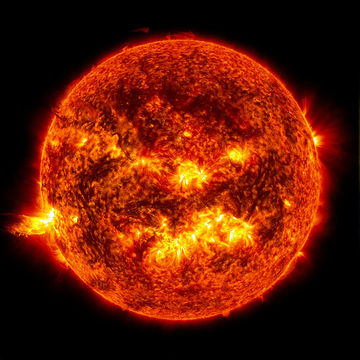Sun

The Sun is the star at the center of our solar system. It is mostly hydrogen - about three quarters of its total mass - and helium - about one quarter of its total mass.[2] The remainder of its mass is other elements found in much smaller quantity adding up to just under two percent of the sun's mass. These elements include carbon, nitrogen, oxygen, neon, magnesium, silicon, sulfur, and iron. Over 50 other elements are found in trace amounts. The temperature of the Sun's surface is 5778 K (5505°C).[3]
Energy from the Sun
The energy from the Sun is vital to life on Earth. Not only does it allow life to exist, but it also is the source of most energy humans use. Biomass, fossil fuels, and some renewable energies such as wind and solar power originate from the Sun. Fossil fuels are simply solar energy stored in a secondary form.[4] The original energy from the Sun is captured through photosynthesis and stored in chemical bonds as plants grow. This energy is then released millions of years later after these plants have transformed into fossil fuels. All fossil fuels are ultimately energy from sunlight. The solar energy to the Earth is significant, even after passing through hundreds of kilometers of the Earth's atmosphere. The solar radiation that reaches the Earth has a significant amount of energy. At full intensity, the solar power to the Earth at the surface of the upper atmosphere is about 1367 W/m2.[5] Taking into account the fact that only half of the Earth faces the Sun, as well as accounting for the different amounts of sunlight that hit different latitudes and the amount of atmosphere the sunlight has to pass through, the average power amounts to around 340 W/m2.
In addition to providing energy, the Sun's energy warms the Earth to a point that it is habitable (the structure of the atmosphere also helps to ensure that the Earth's energy budget maintains a constant, livable temperature). The Sun also creates weather patterns, ocean currents, and air currents.[4]
Layers of the Sun
Satellites have been launched to study the Sun continually. These satellites observe the Sun in a variety of wavelengths that helps to create a picture that describes the inner workings of the Sun. The Sun is believed to be made up of 6 different regions:[6]
- Core: The inner 1/5th of the Sun's radius is known as it's core. Within the core is where nuclear fusion takes place, and thus it is where the energy from the Sun originates. The core has a high concentration of hydrogen atoms being pushed towards the center of the Sun as a result of gravity. When a large number of hydrogen atoms are forced into a small region, they get hot - a temperature of about 13.6 million Kelvin inside the core. When the hydrogen is heated to these temperatures they move faster and faster, colliding with each other more frequently. When fast moving hydrogen atoms collide, they will sometimes initiate a nuclear fusion reaction through the use of quantum tunneling.
- Radiative Zone: This layer is the zone that surrounds the core. The energy generated by the nuclear fusion process in the core is in the form of high energy photons. These photons move outwards through a radiative process.[7] These photons move quickly - at the speed of light - but their frequent collision with other particles results in very slow movement out of the radiative zone because they do not take a straight path outward.
- Convection Zone: This area forms the outer shell of the Sun. Energy is transferred very quickly in this zone through convection. Hotter gas from the radiative zone expands and rises through the convection zone. It can do this because the convective zone is cooler than the radiative zone, and therefore less dense. As the gas rises it also cools, sinking back down. As it gets closer to the radiative zone it heats up again and rises. This process repeats, creating convection currents.
- Photosphere: This portion of the Sun is a thin layer, and it is the layer where the light is emitted. Thus the photosphere is the layer of the Sun that we see from Earth.
- Chromosphere: This is reddish-orange layer of gas. Generally it cannot be seen by the naked eye as the light from the photosphere overpowers it. However, during a solar eclipse it can be seen. It can also be seen in prominences.
- Corona: This is a faint layer of plasma surrounding the surface of the Sun. It can only been seen with the naked eye during a solar eclipse. Temperatures in the corona are often more than one million kelvin.
Figure 2. This is a three dimensional model of the Sun provided by NASA.[8] Drag the image around to look at the Sun from different angles.
For further reading
For more information on the energy that comes from the Sun, see:
For more information on how this energy is important on Earth, see:
References
- ↑ NASA Goddard Space Flight Center. (July 30, 2015). The Sun [Online]. Available: https://www.flickr.com/photos/gsfc/
- ↑ Space. (July 31, 2015). What is Our Sun Made of? [Online]. Available: http://www.space.com/14745-sun-composition.html
- ↑ NASA. (August 4, 2015). Sun Fact Sheet [Online]. Available: http://nssdc.gsfc.nasa.gov/planetary/factsheet/sunfact.html
- ↑ 4.0 4.1 What You Need to Know About Energy. (July 31, 2015). Our Energy Sources: The Sun [Online]. Available: http://needtoknow.nas.edu/energy/energy-sources/the-sun/
- ↑ ITACA. (August 4, 2015). The Sun as a Source of Energy [Online]. Available: http://www.itacanet.org/the-sun-as-a-source-of-energy/part-2-solar-energy-reaching-the-earths-surface/
- ↑ Tim Sharp. (July 31, 2015). Atmosphere of the Sun [Online]. Available: http://www.space.com/17160-sun-atmosphere.html
- ↑ National Earth Sciences Teachers Association. (July 31, 2015). The Sun's Radiative Zone [Online]. Available: http://www.windows2universe.org/sun/Solar_interior/Sun_layers/radiative_zone.html
- ↑ NASA available online herE: https://solarsystem.nasa.gov/resources/2352/sun-3d-model/ accessed July 31st, 2020.

